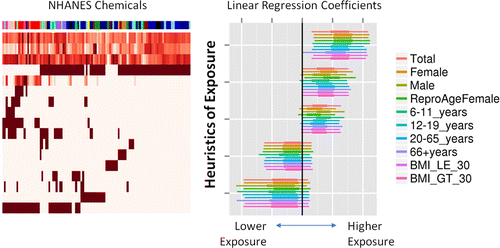Scientists rank thousands of substances according to potential exposure level

An overwhelming number of chemicals from household and industrial products are in the environment – and hundreds are in our bodies. But for most of them, scientists have yet to determine whether they cause health problems. Now they've taken the first step toward doing that by estimating which substances people are exposed to the most. Their new method is published in the ACS journal Environmental Science & Technology.
John F. Wambaugh and colleagues note that the risks to human health of any given substance depend primarily on two factors: the potential hazards a chemical presents, and how much of it people are getting exposed to. But public data on these variables are lacking for many substances already in widespread use. About 80,000 chemicals are registered in the U.S. under the Toxic Substances Control Act, and industry adds 700 to 1,000 new chemicals every year. Directly measuring how much of these substances people are getting exposed to would be a Herculean task requiring the time-consuming analysis of thousands of blood or urine samples. Wambaugh's team sought a more practical approach.
The researchers developed a mathematical model to predict which household and industrial chemicals people are exposed to the most. They based their method on answering five simple questions about the substances, such as whether they are used in consumer products or whether they are pesticides. They used this approach to rank nearly 8,000 chemicals, from highest potential exposure level to lowest. While a few of the top 10 were familiar compounds such as DEHP, a common phthalate that has been shown to cause reproductive problems in rodents, most were substances that scientists know very little about. The researchers say the ranking could help prioritize future efforts that aim to understand potential health risks of thousands of chemicals.
More information: "High Throughput Heuristics for Prioritizing Human Exposure to Environmental Chemicals" Environmental Science & Technology, DOI: 10.1021/es503583j
Abstract
The risk posed to human health by any of the thousands of untested anthropogenic chemicals in our environment is a function of both the hazard presented by the chemical and the extent of exposure. However, many chemicals lack estimates of exposure intake, limiting the understanding of health risks. We aim to develop a rapid heuristic method to determine potential human exposure to chemicals for application to the thousands of chemicals with little or no exposure data. We used Bayesian methodology to infer ranges of exposure consistent with biomarkers identified in urine samples from the U.S. population by the National Health and Nutrition Examination Survey (NHANES). We performed linear regression on inferred exposure for demographic subsets of NHANES demarked by age, gender, and weight using chemical descriptors and use information from multiple databases and structure-based calculators. Five descriptors are capable of explaining roughly 50% of the variability in geometric means across 106 NHANES chemicals for all the demographic groups, including children aged 6–11. We use these descriptors to estimate human exposure to 7968 chemicals, the majority of which have no other quantitative exposure prediction. For thousands of chemicals with no other information, this approach allows forecasting of average exposure intake of environmental chemicals.
Journal information: Environmental Science & Technology
Provided by American Chemical Society


















